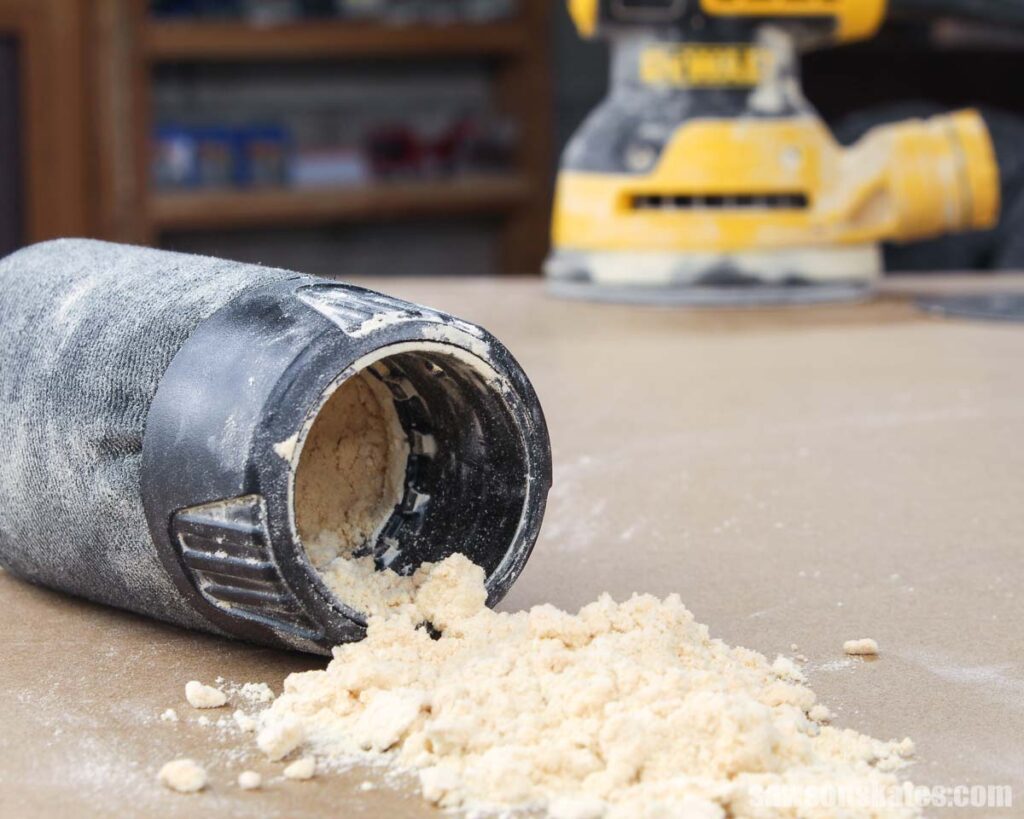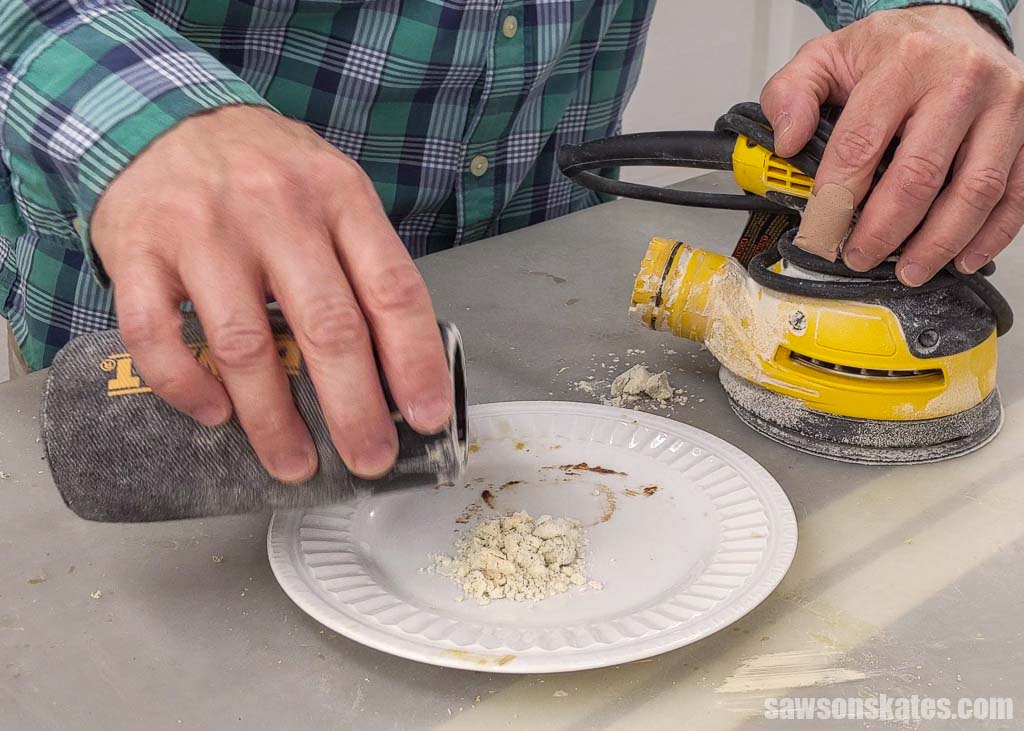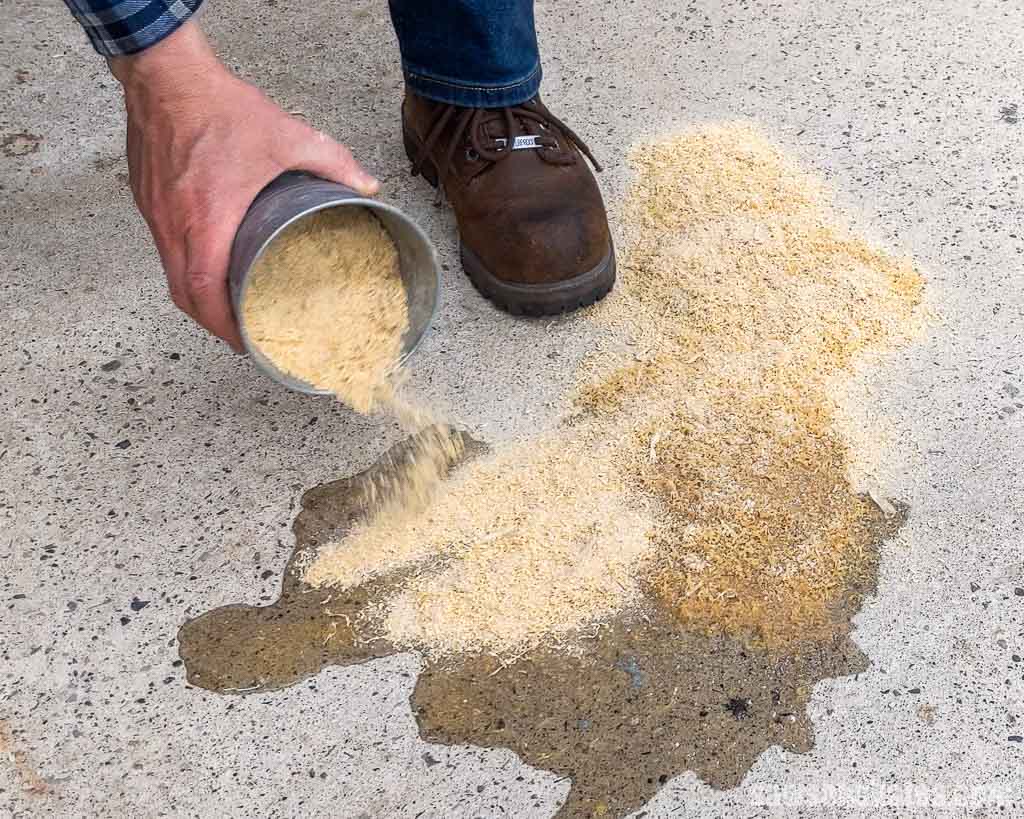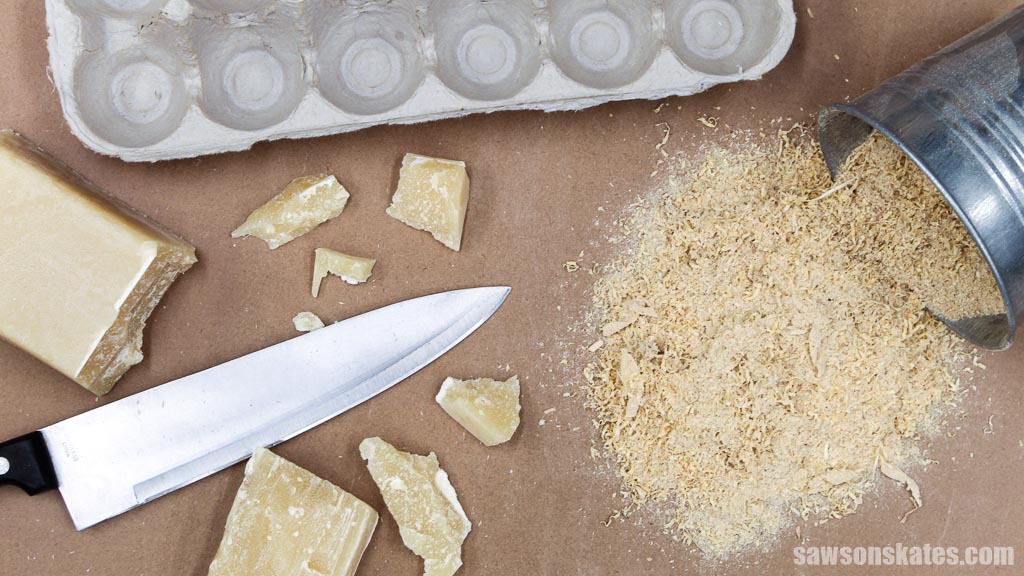Clever Uses for Sawdust (11 Ideas That Will Inspire You)
Don’t know what to do with all that sawdust? Don’t throw it away! Check out these clever ideas for using sawdust around your home and workshop.

I’m a member of a Facebook group for woodworkers, and recently someone asked, “What does everyone do with sawdust?”
Sawdust is often seen as a nuisance, something that has to be cleaned up and thrown away. However, did you know that sawdust can also be used for a variety of purposes?
In this article, I’m sharing 11 clever ways to use sawdust. From crafts to home improvement projects, there are plenty of ways to put this versatile material to good use!
This tutorial contains affiliate links to supplies and tools. Purchases made using these links help support the Saws on Skates website and allows me to share more projects and tips with you. There is no cost to you for using these links. Visit my site policies for more information.
What Sawdust Can You Use?
Nearly 700 people responded to the Facebook request for suggestions about what to do with sawdust.
Many people offered alternatives for using sawdust that might come into contact with plants, animals, or humans. As a result, you’ll want to use sawdust from solid wood boards such as pine, oak, maple, and so on.
Caution: Some Sawdust Might be Harmful
Quite a few responses cautioned against using sawdust from plywood, MDF, OSB, particleboard, and pressure-treated lumber because they contain chemicals that could be harmful to plants, animals, or humans.
They also advised against using cedar or walnut sawdust around certain animals, such as horses, cows, hamsters, or rabbits, because it might cause some to become sick or even worse.
Please do your research or contact a veterinarian to see if cedar or walnut sawdust could harm your animal before using it.
11 Clever Uses for Sawdust
1. Make Wood Filler
One of the most popular suggestions for using sawdust was making your own wood filler to fill nail holes, gaps, and cracks. Many responders mentioned combining sawdust from their sander with wood glue to form a putty.
Related: Wood Putty vs Wood Filler (Which to Use & Why)

I’ve tried several times to create this glue/sawdust mixture and have never been satisfied with the results. In this article, you can see how glue and sawdust compare to other stainable wood fillers.
Related: Does Stainable Wood Filler Really Work? (Here’s the Answer)
I prefer to combine the sawdust with shellac to make a wood filler because I feel it absorbs stains better than a wood glue mixture.
Related: How to Make DIY Wood Filler
2. Alternative to Ice Melt
Responders praised the benefits of sawdust as an alternative for deicer in the winter. They sprinkled it on their icy driveways, walkways, and steps instead of salt which can damage surfaces and harm pets’ paws.
It’s important to mention that the sawdust does not melt the ice, but it does improve traction. When the ice melts, the sawdust absorbs into it. The sawdust makes the surface rougher and less slippery when the ice refreezes.
You might also consider keeping a container in your car during the winter months to help with traction if you get stuck.
3. Clean Spills
I’ve used kitty litter to clean up oil and coolant spills in my garage and paint spills in my workshop on numerous occasions. According to commenters, the absorbency and effectiveness of sawdust is superior to kitty litter when it comes to cleaning up a mess. Plus, it’s free!
One person commented that he sells his extra sawdust to car repair shops for picking up oil spills.
To clean a spill with sawdust, sprinkle a generous layer over the area. Once the sawdust has absorbed the liquid, sweep it with a broom and dustpan, and dispose of it according to your local regulations.

4. Dispose of Paint
Most garbage companies will not allow you to throw away leftover paint with your trash and you shouldn’t pour it down the drain. As a result, I used to bring my old paint to my town’s hazardous waste day to dispose of it.
On one of the hazardous waste day trips, an employee said I could allow the paint to dry and then throw it in the garbage. So I tried it. I removed the lid from the can, and it took FOREVER for the paint to dry.
A much quicker way to dispose of old paint is to mix it with sawdust. The ratio doesn’t have to be exact, but a good starting point is one part paint to three parts sawdust. Once mixed, leave it uncovered until it’s dry, and then throw it away.
5. Make Fire Starters
Many people on the Facebook thread suggested making fire starters with sawdust. They combined sawdust with everything from paraffin wax, candle wax, and old food-grade cooking oils. Some even added dryer lint for good measure!
I may try to make some starters with leftover beeswax from my homemade wood polish.
Related: How to Make a DIY Beeswax Wood Finish

They melted the ingredients and then poured the mixture into anything from cardboard egg containers, toilet paper tubes, paper cups, or even silicone muffin pans to dry.
Some used the starters for campfires, fire pits, or backyard chimineas, while others sold them as natural fire starters.
Here’s a less than two-minute video that shows how easy it is to make fire starters with sawdust.
6. Use it for Crafts
Sawdust has a lot of potential for crafters. Use sawdust with white paint and glue to make fake snow for holiday decor. Mix it with green paint and glue to create grass. One commenter used the mixture for his railroad layout.
Related: What is PVA Glue? (Types, Benefits & Uses)
7. Use it in Your Garden
⚠️ IMPORTANT: Before using sawdust in your garden, please see the warning about the risk of using certain types of sawdust around plants and humans.
Add to Your Compost Pile
Many of the responses suggested adding sawdust to a compost pile. Adding sawdust to your compost pile will add some nutrients, aid in decomposing the other materials, and aerate the soil. This is a great way to reduce waste and create nutrient-rich compost for your garden.
Related: How to Make a DIY Tiered Raised Garden Bed
Use it as Mulch
Sawdust can also be used as mulch for your plants. Add a layer of newspapers or cardboard underneath the sawdust to help retain soil moisture and keep weeds at bay.
Fill Holes in the Yard
Another way to use sawdust is to fill holes in the yard. Simply mix the sawdust with some topsoil and fill in any divots or depressions in your lawn. This is a great way to use small amounts of sawdust and give your yard a nice, even appearance.
Make a Garden Path
If you have a garden, you can use sawdust to create a path. Simply lay down a layer of newspapers or cardboard and top it with sawdust. This will help keep weeds at bay and provide an attractive surface to walk on.
Natural Weed Killer
Walnut trees produce juglone, a chemical compound toxic to many plants, so you can use walnut sawdust as a natural weed killer.
Spreading walnut sawdust over soil or sidewalk cracks can cause unwanted plants to die or inhibit their growth. The drawback is it can also affect the garden plants you want, such as tomatoes and potatoes. Iowa State University has a complete list of plants tolerant and sensitive to juglone.
It’s important to note that walnut sawdust can harm humans and animals like dogs and horses. In humans, ingesting juglone can cause nausea, vomiting, diarrhea, abdominal pain, headache, dizziness, seizures, and in severe cases, even death.
Contact with juglone can cause skin irritation, redness, and swelling. Inhalation of juglone can cause respiratory problems, such as coughing, wheezing, and shortness of breath.
The amount of juglone harmful to humans varies depending on the individual. Some people, such as those allergic to tree nuts, are more sensitive to it than others. If you think you’ve been exposed to juglone, it is vital to seek medical attention immediately.
While walnut sawdust has the benefit of being a natural weed killer, it can be harmful to you, your animals, and the plants you want to keep, so it’s essential to weigh its pros and cons before using it.
If you decide to use it, exercise proper safety measures, such as wearing gloves and a face mask, when working with it, and avoid using it around sensitive plants and animals.
8. Bedding for Animals
⚠️ IMPORTANT: Before using sawdust as bedding, please see the warning about the risk of using certain types of sawdust around some animals.
Sawdust can also be used as bedding for animals such as hamsters, gerbils, and guinea pigs. This is a great way to recycle sawdust and provide a comfortable place for your animals to sleep. Simply add a layer of sawdust to your animal’s cage or pen and change it out as needed.
One commenter said he gives the wood shavings from his planer and jointer to a neighbor for their chicken coop. In exchange, the neighbor gives him fresh eggs. That’s a win-win!
Related: Jointer vs Planer: Differences & Which to Buy First
Another responder advertises his extra sawdust for free on Facebook Marketplace. He has two farmers who pick up the sawdust for their chickens and goats.
9. Natural Kitty Litter
⚠️ IMPORTANT: Before using sawdust as kitty litter, please see the warning about the risk of using certain types of sawdust around some animals.
Sawdust can also be used as natural kitty litter. Simply add a layer of sawdust to your cat’s litter box and change it out as needed.
Related: How to Make a DIY Hidden Litter Box Cabinet
10. Clean Furniture Stripper
When refinishing furniture projects, sawdust may be used to remove the stripper. Simply add a layer of sawdust to the stripper and let it sit for a few minutes. The sawdust will absorb the stripper and make it easier to wipe off the surface.
11. Clean Floors
Wet some sawdust with water and sweep it around your garage, basement, or workshop’s concrete floor with a push broom. Dust and dirt will be trapped and absorbed by the moist sawdust.
Burn It
While you can burn sawdust in a campfire or fire pit, it’s important to be cautious.
A reader named Danny messaged me with a real-life close call when he emptied the sawdust bag from his miter saw into a fire:
- Sawdust can flare up and explode like grain dust, which can be dangerous.
- Danny said, “I haven’t burned any since and now go the compost route instead. I would hate to see anyone hurt from adding sawdust to a fire.”
Where to Get Sawdust
If you’re a woodworker, you likely have several woodworking machines where you can collect sawdust. The dust bag on your random orbital sander is a great place to get fine sawdust for making wood filler.
Related: Best Sanders for Furniture: Which One to Buy & Why
Miter saws produce an unending amount of sawdust. The dust hood behind my miter saw controls and collects the dust in my small workshop.
Related: DIY Miter Saw Dust Hood (Detailed Plan + Supply List)
If you have a dust collection system, this is an excellent location to gather a lot of sawdust.
Related: My Small Shop Dust Collection System
You can also go to your local sawmill and ask if they have any sawdust they’d like to get rid of. Many places are happy to give it away for free.
Final Thoughts
Next time you’re faced with a pile of sawdust, don’t throw it away. There are plenty of ways to put it to good use. Now it’s time to get creative!
Thank you for stopping by. If you enjoyed this tutorial, would you please take a moment and pin it to Pinterest? I’d really appreciate it!


Saw dust or wood chips from fruit and nut woods can also be use in a smoker or in a tin foil packet on a grill to add a lovely smoky flavor to you cooked meats.